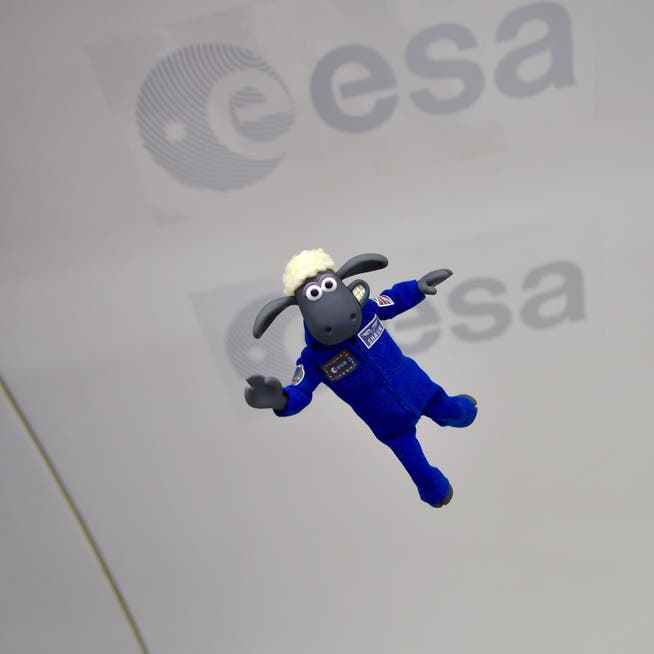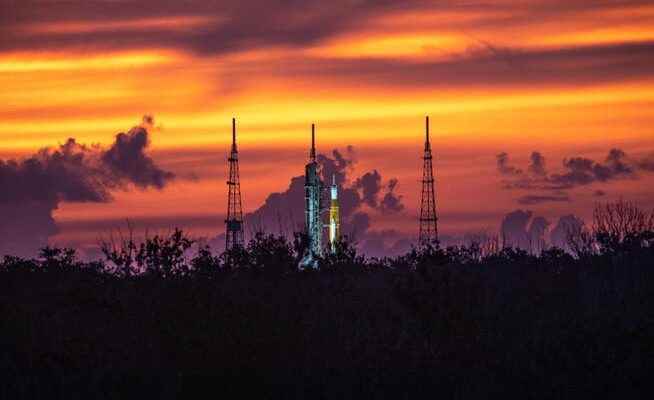After more than ten years of construction, the Space Launch System faces its first test on Monday. If she succeeds, there could soon be a return to the moon.
Live transmission of the mission.
live ticker
1:22 p.m .: Technical problems are worrying Nasa
Shortly before the launch of the new heavy-duty rocket, NASA reports technical difficulties. A crack was apparently discovered in the part of the rocket that connects the liquid hydrogen tank and the liquid oxygen tank. According to a NASA statement, engineers are currently investigating the problem. The team is also investigating a fault in one of the four large RS-25 engines. It is currently unclear if and when the rocket can start. The start countdown has been stopped for the time being.
Engineers are working through @NASA_SLS pre-launch tanking operations. We will continue to share #Artemis updates. https://t.co/z1RgZwQkWS
— NASA (@NASA) August 29, 2022
Why is?
Weather permitting, the Space Launch System will launch the Orion spacecraft into orbit around the moon on Monday. The unmanned flight marks the start of the Artemis program, which will bring NASA, ESA and other space organizations back to the moon in the next few years.
Unlike the Apollo mission, this time the partners are aiming for a permanent presence on Earth’s satellite. A space station is to be built in lunar orbit, from which equipment and astronauts will be brought to the moon. And settlements are also to be built on the moon. In the long term, this is used to prepare for a mission to Mars here. But it is also about scientifically exploring the moon and staking claims to mineral resources.
The Space Launch System awaits launch at Kennedy Space Center in Florida.
How powerful is the Space Launch System?
The Artemis program stands and falls with the possibility of bringing astronauts and heavy loads into lunar orbit. NASA has not been able to do this since the end of the Apollo program in 1972. This is why manned space travel has taken place exclusively in low-Earth orbit over the past 50 years.
With the Space Launch System (SLS), Nasa is now back in deep space. The multi-stage rocket has enormous thrust. This allows it to transport a payload of 95 tons to low Earth orbit and one of 27 tons to lunar orbit. The Space Launch System is the only rocket capable of launching the Orion spacecraft directly into lunar orbit. The heavy-duty rockets from other manufacturers would have to be converted for this.
A later version of the Space Lauch System is said to carry even more than 40 tons to the moon. This would make the rocket comparable to the legendary Saturn V used during the Apollo program.
What did Europe contribute to the Orion capsule?
At the top of the rocket is the Orion spacecraft. It is the counterpart to the Apollo spacecraft, which brought three astronauts to the moon at the time. The Orion space capsule is designed for four astronauts. It consists of three modules: the crew module, a rescue system that catapults the crew away from the rocket in the event of a false launch, and the service module. The latter is the European contribution to the Artemis 1 mission. Developed by 26 companies led by Airbus, it supplies power, water and oxygen to the space capsule. It also keeps the capsule on course as it orbits the moon.
Unlike the Space Launch System, the Orion spacecraft has already passed its baptism of fire. In 2014, she completed an unmanned test flight. Since the Space Launch System was not yet complete at the time, the capsule was launched into Earth orbit on a United Air Alliance rocket. After four hours, she re-entered the Earth’s atmosphere and landed in the Pacific Ocean.
How long does it take to fly around the moon?
The flight to the moon and back will take place in different stages. In total, it will last between 26 and 42 days. This can only be said more precisely when the exact time of the start is known. Because depending on the start date, the flight takes longer or shorter. This has to do with the constellation of the earth and the moon. If the August 29 launch has to be postponed, there will be additional launch windows on September 2 and 5.
In its orbit, the Orion capsule comes within a hundred kilometers of the moon. At the furthest point of its journey, it will be a thousand times farther from Earth than the International Space Station. Their distance to the moon is then 65,000 kilometers.
When will a manned flight follow?
Artemis 1 is an unmanned reconnaissance mission that is primarily used for testing purposes. Dolls equipped with numerous sensors will take the place of the astronauts. Among other things, the choice fell on Shaun the Sheep and Snoopy from the Peanuts comic series. The first flight with real astronauts is scheduled for 2024. It will also go around the moon, but will only last ten days.

Shaun the Sheep prepares to circumnavigate the moon on a parabolic flight.
According to current plans, the first moon landing should take place in 2025 at the earliest. Then, for the first time, a woman and a colored astronaut will set foot on the moon. NASA recently announced possible targets for the Artemis 3 mission. They are all located near the lunar south pole. This region is particularly interesting for a future colonization of the moon. Because in the deep, shadowy craters one suspects water ice.
NASA needs support from SpaceX to land on the moon. Elon Musk’s company has received a $2.9 billion contract from NASA to build a lunar module. This should dock with the Orion capsule in lunar orbit and bring two of the four astronauts to the moon and back to the capsule. Other private companies are also developing lunar modules.
Who else wants to go to the moon?
Nasa and ESA are not the only space organizations drawn to the moon. China is also pursuing ambitious plans. By 2035, the country wants to build a small settlement on the moon and create the conditions for mining raw materials there. To achieve this, China wants to work together with Russia.
Nations that have not yet played in the concert of the big ones also want to go to the moon. India, Japan, South Korea and the United Arab Emirates have announced robotic missions. For them, the moon is a suitable destination to gain or deepen experience.
Finally, there are private space companies like SpaceX or Blue Origin. They will be of particular importance in the years to come. On the one hand, they cooperate with NASA as part of the Artemis program, for example by developing landing gear for the moon. On the other hand, they pursue their own plans. SpaceX is currently developing a new rocket that is said to be even more powerful than the Space Lauch system. Although a test flight of the Starship is still pending, there is already a first customer. A Japanese billionaire has chartered the Starship for a trip around the moon. However, it is more than questionable whether this can take place as planned in 2023.
Follow the science editors of the NZZ Twitter.
